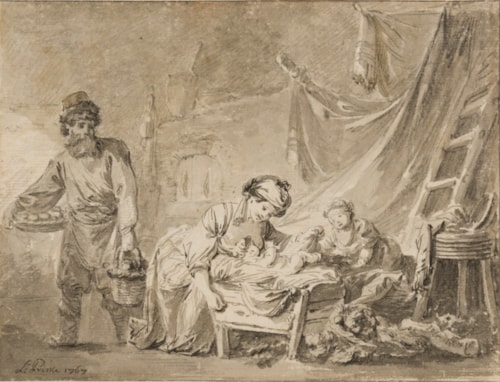
Jean-Baptiste LE PRINCE
Metz 1734 - Saint-Denis-du-Port 1781
Biography
Born in the town of Metz in northern France, Jean-Baptiste Le Prince studied in Paris with François Boucher, who was then at the height of his career, before making a brief visit to Italy in 1754. Not long afterwards, in 1758, he travelled to Russia. Despite the fact that he arrived in the country almost unknown as an artist, within a few weeks he was engaged on the painted ceiling decoration of a room in the newly-built Winter Palace in Saint Petersburg. Le Prince was to remain in Russia for five years, working mainly at the Winter Palace, although most of his work there was later destroyed by fire. He also travelled extensively throughout the country, venturing as far east as Siberia, and his experiences led him to produce a large number of drawings of Russian life, costumes, events, scenery and customs. These drawings served as the basis for much of the artist’s later work, both as studies for paintings and as designs for engravings, following his return to France in 1762 or 1763.
In December 1764, Le Prince announced the publication of a series of thirty-six prints made from his drawings (‘5 suites d’Habillemens d’après le figures dessinées en Russie’), followed by a further group of etchings issued the year after, and others in 1767 and 1768. (Other printmakers, such as Gilles Demarteau and Louis-Marin Bonnet, also produced engravings of Russian subjects after his drawings.) Elected to the Académie Royale in 1765 with a genre painting entitled The Russian Baptism, Le Prince exhibited fifteen paintings of Russian subjects at the Paris Salon of that year. At around the same time he provided thirty-two drawings to illustrate the Abbé Jean Chappe d’Auteroche’s Voyage en Sibérie, published in 1768. In the preface to the book, Chappe wrote, ‘The drawings which accompany the descriptions of local customs are by Monsieur Le Prince, of the Academy of Painting: one sees by the beauty of his compositions, the richness of his imagination, and his rare talent for drawing costumes and nature, that he has studied in Russia.’ Le Prince’s drawings for the Voyage en Sibérie have been described as ‘among his most significant works…Highly finished and minutely detailed, the exotic images in the Voyage drawings provide a vocabulary for virtually all of the artist’s later work.’
Le Prince continued to produce paintings, drawings, suites of prints and tapestry cartoons of Russian subjects well into his later career, these russeries taking their place alongside the popular taste for similarly exotic chinoiserie and turquerie subjects. He regularly exhibited both paintings and prints at the Salons and was one of the first artists to develop and perfect the medium of aquatint as a printing process, producing a number of what he termed ‘gravures au lavis’ between 1768 and 1774. (As Perrin Stein has noted, ‘Le Prince’s ability with ink wash [as a draughtsman] undoubtedly played a role in his contributions to the development of the aquatint technique in printmaking, in which areas of uneven ground are successively stopped out with varnish to create etched plates in imitation of ink-wash drawings.’) Ill health led Le Prince to retire to the country in 1775, when he also began to move away from Russian subjects in favour of less exotic landscapes and pastoral scenes. As the 19th century scholar Baron Roger Portalis wrote of the artist, ‘Leprince’s manner is wise and grand; his drawings, where the landscape often plays a major role, are well composed, and it is said of him that he had managed to extend to his works the happy gift that he had of making himself loved.’
At the sale of the contents of the artist’s studio, held in November 1781 after his death, the auction catalogue listed numerous drawings of Russian subjects, as well as twelve sketchbooks made during his travels in the country (‘Douze petits Cartons contenant des Croquis faits en Russie, d’après nature’) and several Russian costumes. Significant groups of drawings of Russian subjects by Le Prince are today in the museums of Saint Petersburg and Moscow, as well as the Musée des Beaux-Arts in Rouen and the Rosenbach Museum and Library in Philadelphia, which houses an almost complete set of drawings for Chappe d’Auteroche’s Voyage en Sibérie.


